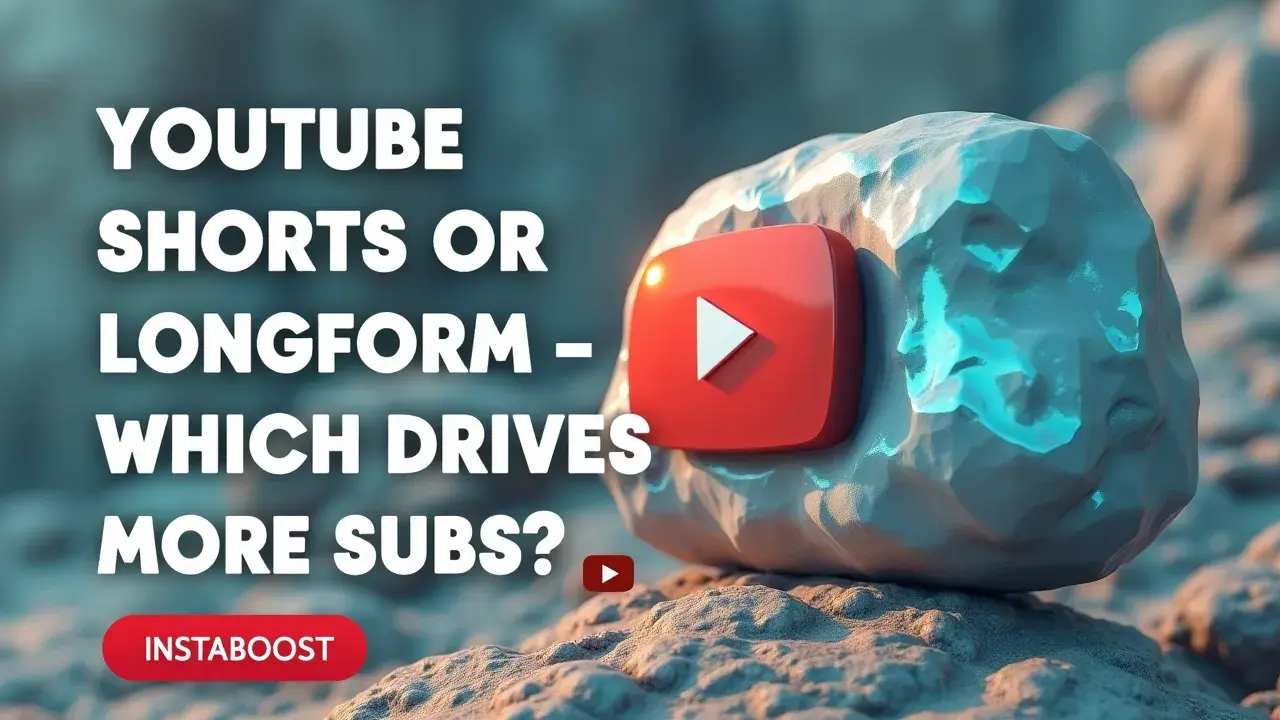Which Drives More Subs? YouTube Shorts or Longform?
Shorts typically spark fast discovery, while longform more often converts that attention into lasting subscribers. Short bursts can lift visibility on new topics, then deeper uploads channel interest into repeat views and sign-ups. Track watch time and retention for both formats to see which truly sustains audience behavior across sessions. A smart path balances quick reach with substantive videos, aligning content depth to measured engagement patterns.
The Real Question Behind “Subs”
Creators often ask whether YouTube Shorts or longform brings in more subscribers, but the better question is how each format moves someone from a quick touch to a committed follow. Shorts give you reach you can’t reliably buy elsewhere, and that spike compounds when your deeper videos catch the spillover with strong retention, clear next steps, and a reason to come back, and you can push your YouTube content wider without diluting the core loop. Longform rarely pops overnight, yet it trains the algorithm on session quality and gives viewers enough context to trust you, which fuels subscribe intent.
The choice isn’t binary. It’s about sequencing and measurement. If you lead with Shorts, point end screens to a thematically matched long video, pin comments with a specific ask, and keep your analytics clean so you can trace the path from quick view to sub. If you lean longform, seed timely Shorts to test hooks and topics, then put modest, reputable ads or creator collabs behind the winning angles to build early momentum. Conversion happens in the handoff. People who found you fast will subscribe when the next touch proves depth, consistency, and a repeatable payoff.
Treat “YouTube Shorts vs longform” as a funnel design problem, not a format debate, and the testing loop becomes obvious. Optimize for retention on the video that does the convincing, and for qualified reach on the one that does the introducing. Done right, either can drive subs – together, they compound.
Treat “YouTube Shorts vs longform” as a funnel design problem, not a format debate, and the testing loop becomes obvious. Optimize for retention on the video that does the convincing, and for qualified reach on the one that does the introducing. Done right, either can drive subs – together, they compound.

Borrowed Trust Beats Raw Reach
I’ve watched a “perfect” funnel stall because the first sentence was off. The hook promised a tutorial, the video delivered a rant, and people left before the value landed. That mismatch cut retention, which cut the suggested traffic that would have carried the series and, more importantly, kneecapped subscribe intent. Credibility on YouTube isn’t a vibe. It’s a chain of signals: promises kept in the first 15 seconds, watch time that climbs after the intro, comments that show real takeaways, and a clean handoff to the next video that fits why they clicked. Shorts or longform can both build subs when each link lines up.
When a Short teases the exact depth your longform pays off, the algorithm sees longer sessions and shows you to more of the right people. When longform calls back to a specific Short and answers comments on-screen, viewers feel seen and stick around. Add qualified boosts – limited whitelisting with reputable partners or a small, targeted promotion – and you amplify proof, not vanity. Collabs compound this. Borrow a creator’s context, not just their audience, by co-creating a sequence – Short to 8-minute deep dive – that matches their viewers’ intent. Keep analytics clean with separate playlists for experiments, annotations that don’t cannibalize retention, and UTMs on off-platform pushes so you can attribute growth; shortcuts like buy real YouTube followers don’t fix coherence and often muddy attribution.
If you want early momentum, use reputable promo to seed 1,000 – 3,000 views on a cornerstone longform, then point three thematically tight Shorts at it. The non-obvious insight is simple: subscribers come from coherence – the first sentence, the thumbnail, the pacing, and the payoff aligning – and that credibility multiplies every other lever in the YouTube Shorts vs. longform debate.
Design a Two-Speed Funnel You Can Actually Measure
You don’t need more features – you need more clarity. Treat Shorts as your reach engine and longform as your trust engine, then link them into a path viewers can follow without thinking. Start with a two-step journey: a Short that answers one sharp question and points to a named next video, and a longform upload that delivers on the promise with tight structure, clear chapters, and a single ask. The pairing works when the Short’s hook mirrors the first 15 seconds of the longform – borrowed trust breaks if the tone or topic swerves. Keep the analytics clean: tag Shorts with consistent end-screen templates, add UTMs in descriptions when you run targeted promotion, and separate traffic sources so you can see how Shorts discovery rolls into suggested views and session watch time; if you rely on any third-party boosts, treat them like a testing variable the same way you would buy YouTube likes safely, tracking their impact against retention and downstream session time.
Optimize for retention signals, not vanity spikes. Pin a comment that bridges to the deeper video, mine real comments to fuel follow-up Shorts, and schedule creator collabs around episodes that already show strong average view duration. If you buy a push, choose qualified placements or a reputable promo partner and cap budgets to protect your testing loop – the aim is early momentum matched to viewer intent, not inflated reach. Build in a weekly safeguard: compare longform subscribers per 1,000 views, Short-to-long click-through rate, and returning viewer growth. Those reveal whether Shorts or longform is actually driving subs on your channel. When the numbers dip, iterate the first sentence and thumbnail pair before you rewrite the topic. Do this for six weeks and you’ll see a compounding effect – Shorts keep opening the door, longform keeps people in the room, and subscribe intent follows the clearest path.
The Algorithm Isn’t Biased – Your Signals Are Mixed
Maybe you’re not stuck – maybe the platform feels off because your signals are mixed. When Shorts pop but longform stalls, it’s easy to blame the algorithm, yet mismatched intent is usually the culprit. Your reach engine fires, then your trust engine delivers a different promise, viewers bail, and retention signals slide. That’s why “Borrowed Trust Beats Raw Reach” matters. Viewers will forgive a lower‑production Short if the longform that follows pays off the hook line by line. If you link a Short to a clearly named next video and the first 20 seconds of that longform mirror the Short’s promise, you get a clean read on subscribe intent.
It works when you add safeguards: chapters that map to the teaser, one focused call to action, and pinned comments that restate the path. Collabs help if the guest’s audience is matched to the topic and you seed real comments early to anchor quality signals. Paid promotion is useful when you target viewers who watched 75% of related Shorts, and while you can boost your channel's visibility with a nudge, pushing cold traffic to a 14‑minute deep dive often hurts average view duration. YouTube Shorts can swell discovery, and subs come from predictable satisfaction – consistent intros, tight midroll structure, and a single “why subscribe” moment before the last 20% of runtime to avoid exit spikes.
Keep analytics clean. Separate tests by topic and thumbnail family, run A/Bs in non‑overlapping windows, and track longform watch time per 1,000 Short impressions. That metric shows whether your two‑speed funnel actually converts. If it doesn’t, fix message match before you scale, then apply targeted promotion for early momentum and let retention carry you.
Ship the Loop, Not the Video
You don’t need certainty. You need motion. Treat this like a closing brief: choose one lane for discovery and one for conversion, then connect them so your retention signals tell a single, coherent story. The question isn’t Shorts or longform – it’s “what’s the next click?” If your Short hooks on one clear pain point, the linked longform should resolve that exact tension in the first 30 seconds and keep the promise through chapters – no vibe shift, no new topic. Do that and watch time stacks, comments get specific, and the platform recognizes a clean path worth amplifying. Use targeted promotion to seed early momentum on launches – collab intros inside Shorts, pinned comments that echo the same call to action, end screens that match the title and thumbnail viewers just tapped; if you’re testing share velocity as a signal, a small, vetted nudge from YouTube share boost that works can be a reference point as long as you judge it against session-level retention.
Paid boosts can work when they’re from qualified sources and measured against session-level retention, not vanity views. Build a weekly testing loop: two Shorts that tease one named outcome and one longform that delivers it. Review audience retention and real comments Friday, then refine hooks Sunday. Keep analytics clean by tagging campaigns, separating returning and new viewers, and filtering out mismatched traffic so you can see which format actually drives subscribers. If monetization is part of your plan, track the boring metrics that matter – average view duration, suggested-surface CTR, and how many views you need to monetize on YouTube – side by side with sub conversion. The non-obvious part is that the channel that wins isn’t louder. It’s more legible. When your reach engine and trust engine express the same promise on different timeframes, you won’t have to choose between YouTube Shorts and longform. Your audience – and the algorithm – will choose for you.
Prime the Click, Then Prove the Fit
If you want Shorts or longform to drive more subs, treat the first touch as a qualified promise and the follow-up as proof of fit. Your Short should set up one clear tension that maps cleanly to a specific next step, and your linked video should resolve it with a decisive early payoff, not a tease. Viewers who feel seen in the first five seconds will accept a higher ask, but only if the throughline holds – same problem language, same tone, same outcome.
Add light, targeted promotion once the loop performs organically; some teams even bundle their workflow to simplify operations in one place with simplify YouTube marketing in a pack as a shorthand for keeping assets aligned. A small push with reputable placements or creator collabs can build early momentum without polluting your analytics. The smart move is to measure conversion per view, not views alone. If a Short gets broad reach but weak click-through to your longform, the promise is mismatched.
If longform holds retention but lacks comments that reference the hook, the setup is off. Aim for clean retention signals and comments that mirror your CTA language, since both are strong proxies for intent. When testing, isolate variables. Keep thumbnails and titles congruent, change one angle at a time, and timestamp the payoff so viewers feel the win fast. You don’t need to pick Shorts or longform as a religion – you need a reliable sequence that moves cold discovery to warm consideration and then to subscribe. Do that with safeguards – tight hooks, chaptered resolution, clear CTAs – and the question shifts from format to flow, and your YouTube subscriber growth starts to look inevitable rather than episodic.















